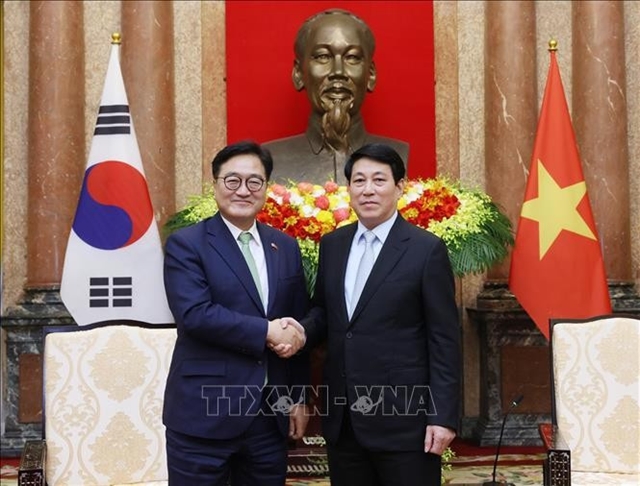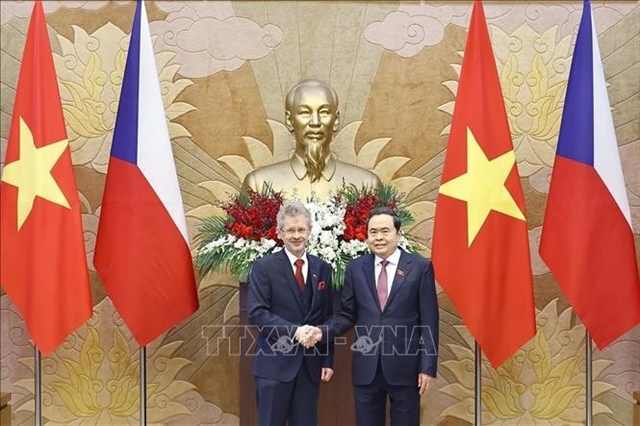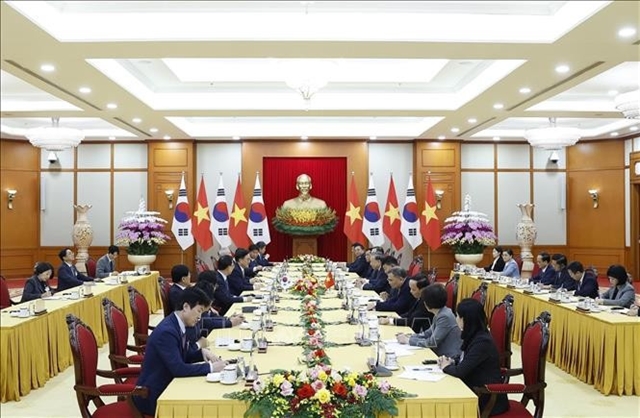 Features
Features
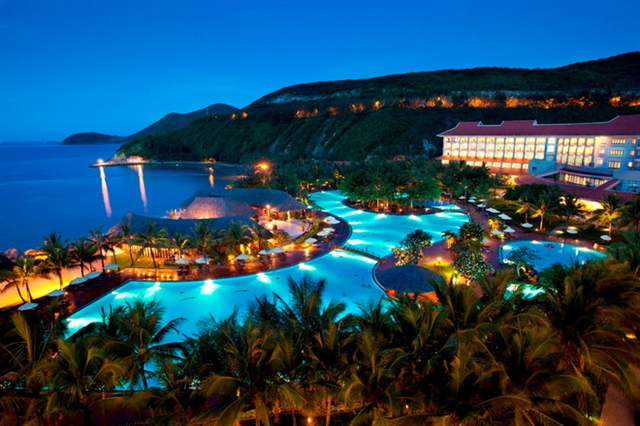
Two children on a trail between rice fields that were photographed by US Army photographer Ronald L Haeberle were later identified as survivors of the massacre on March 16, 1968, when 504 unarmed villagers were killed by soldiers of Charlie Company.
It’s been 51 years since former US Army photographer Ronald L Haeberle documented the tragic Mỹ Lai Massacre on March 16, 1968, when 504 unarmed villagers – 182 women, and 173 children and infants – in the centre of now Tịnh Khê Commune, in Sơn Tịnh District, were killed by soldiers of Charlie Company, under the command of Lieutenant Willam Calley Jr.
Two children on a trail between rice fields that were photographed by Haeberle were later identified as survivors of the massacre.
By Công Thành
Trần Văn Đức, 58, returned to Mỹ Lai Village – where his mother and sister were buried in a mass grave of 75 villagers killed by American troops in a massacre in 1968 – earlier this year during a visit back to Việt Nam.
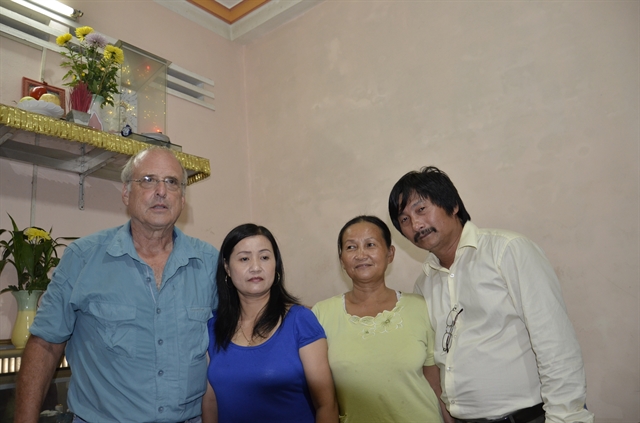
|
| BONDED BY TRAGEDY: Former US Army photographer Ronald L. Haeberle (first left) poses for a photo with Trần Văn Đức (first right) and his sisters Trần Thị Hà (second left) and Trần Thị Mỹ - three survivors of the Mỹ Lai massacre. Photo courtesy of Trần Văn Đức |
Đức, a Vietnamese-German-Vietnamese national, and his two sisters Trần Thị Mỹ and Trần Thị Hà were among the few to survive the bloody massacre.
US Army photographer Ronald L Haeberle took an iconic and haunting photo of Đức and his younger sister Hà amidst the carnage, but it took a decade for the pair to be identified.

|
| ICONIC: Photos of a helicopter and two survivors of the Mỹ Lai massacre taken by Ronald L. Haeberle. The two survivors - Trần Văn Đức and and his sister Trần Thị Hà - are still alive. Photo courtesy of Ronald L. Haeberle |
Haeberle and Đức first met at the former's house in Ohio, the US in 2011 – where the American photographer presented Đức the Nikon camera he used to capture the massacre.
Đức recalled the morning 51 years ago when his mother Nguyễn Thị Tẩu, eldest sister Trần Thị Hồng, 11, nine-year-old Mỹ, five-year-old sister Trần Thị Huệ and 14-month old Hà were preparing for breakfast when the carnage began in Tư Cung Hamlet.
“The village was woken up by helicopters and close range gunfire, and my family left our breakfast. My mother rushed to pack belongings and money. She urged us to get away from home,” Đức recalled.
“I was told to carry a money package on my thigh, but I refused as it was uncomfortable. My sister Mỹ took it before we rushed out for shelter. All villagers ran out for tunnels – which were dug in household gardens as covering for bombardments – but they were forced to exit the tunnels by American soldiers,” he said.
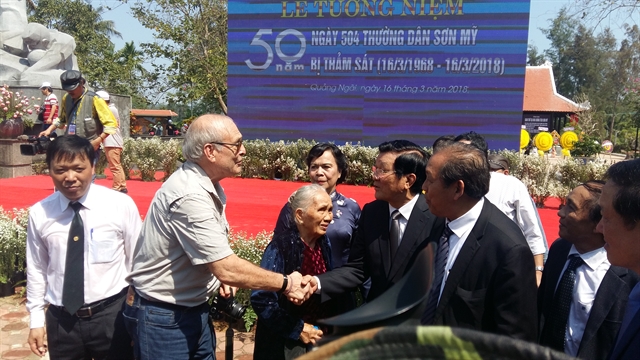
|
| SAD ANNIVERSARY: Former US Army photographer Ronald L. Haeberle (2nd left) shakes hands with former Việt Nam President Trương Tấn Sang (4th right) and Deputy Prime Minister Trương Hòa Bình (3rd right) on the occassion of 50th anniversary of the Mỹ Lai massacre in Sơn Tịnh District of Quảng Ngãi Province last year. VNS Photo Công Thành |
Đức, who was then seven, remembers that his mother took him and baby Hà in her arms to hide behind a hedge, but an American soldier spotted them.
All the villagers then gathered in a group by American soldiers. Machine gunfire began hitting the crowd, killing many people before they could even flee into the rice fields.
“My mother fell down to cover me and Hà. She was injured in her thigh, while deafening gunfire kept us on the ground. The gunshots ceased for a moment and my mother pushed Hà to me and said: ‘Take Hà to grandmother, quick',” he recalled.
“I could see my mother while fleeing along the edge of the paddy field to avoid gunfire. A bullet hit Hà and caused an injury, but we kept running along the edge of the field as the high rice helped cover us.”
Đức said the two got 300m from home before a helicopter swooped down in front of them, flying low.
“I just lay down to cover Hà as I was afraid of gunfire launch from the helicopter. However, the helicopter then lifted up and left us. I could clearly see an image of a shark painted on the helicopter.
"Hà was crying so much on the way to my grandmother, she was scared of the gunfire and noise from the helicopters. She fainted in my arms in the last section to my grandmother in Tịnh Long Commune – 7km from my house," he said.
Trần Thị Mỹ, Đức’s older sister, recalled she was holding Huệ in the crowd when a gunshot killed the five-year-old.
“I was scared of the gunshots and killing. I left Huệ and fled with a group of villagers because American soldiers came closer to shoot anyone who was still alive in the pile of corpses,” Huệ said.
“I just followed the crowd running as far as I could from the gunfire. Some fled in the rice fields or on the edge of fields. I just returned to my grandmother the next day when I knew my mother and my younger sisters Huệ and Hồng were killed.”
Đức said the 7km trip from his house to his grandmother's was the longest journey in his life, one he had taken hundreds of times.
“Many neighbours came to help us. A doctor was called to give first aid for Hà’s injury. A bullet fragment had torn my skin on my forehead, while a tiny fragment hit Hà’s waist,” he recalled.
The three sisters and brother were then raised by their grandmother because Đức’s father, a guerrilla, was killed in 1969.
Mother’s death
Đức did not know how his mother had died in the slaughter until 2011 when he decided to search for the truth.
He then contacted photographer Haeberle, and told him he was the boy in his infamous photo of the massacre.
The two returned to the village later that year to confirm Đức and his sister were the two children in the photo, the older boy sheltering his sister from gunfire beside a paddy field.
Back on March 16, 1968, Haeberle carried two cameras, one assigned by the US Army with two rolls of black and white film. He returned these rolls of film to the commander of Charlie Company, but kept his own camera, with which he took 18 colour photos that were published in Life magazine, exposing the truth of the horrific massacre.
Haeberle's iconic black and white photographs become all the more visceral when seen at the Mỹ Lai Massacre Museum.
Captions like “Most were women and babies. It looked as if they tried to get away”, are redundant – as if the scene of women and babies piled up on a path needs an explanation.
“My photos of the massacre told the world the truth about what happened 50 years ago. The true story had not been told in America and the world. I just wanted to tell everyone about the massacre with my photos from the field,” Haeberle said on the 50th anniversary of the mass killing in 2018.
“I have visited the site several times since I left Việt Nam in 1969,” he said.
Haeberle was convinced Đức and Hà would have died then.
“I was very surprised when I received the word that Đức and Hà were alive. At the time I assumed they were shot after I've taken the photo of the two children because of all the gunfire around me. The two children were alive when I left the area,” Haeberle told Việt Nam News via email.
“I felt a sense of happiness and relief that due to Đức's and my perseverance to correct, history was accomplished after many years of research, providing Đức with valuable material/documents to help him further his research on the photograph of the two children on a trail.
“Đức and I developed a close relationship that has grown over the years. We both had a goal to make a wrong right."
In the middle of gunfire and killing, Larry Colburn (machine gunner on helicopter), Hugh Thomson (pilot), crew chief Glenn Andreotta and Dan Millians (pilot of HU1A) rescued many villagers from the massacre on their helicopters on that day.
Đức said Colburn paid a visit to Đức’s family in Germany in July 2011.
In September 2011, Đức went to Cleveland for a nine-day visit at Haeberle's house, when he met Colburn during transit in Atlanta.
Colburn died in 2016, while Hugh Thomson passed away in 2006.
Sorrow
Đức’s mother, Nguyễn Thị Tẩu, and his sisters Trần Thị Hồng and Trần Thị Huệ were buried in a 75-victim mass grave in the village.
Đức studied a mechanical course and soon found a labour contract to work in Dresden, Germany in 1983 before moving to a textiles factory after the Berlin Wall fell in 1990.
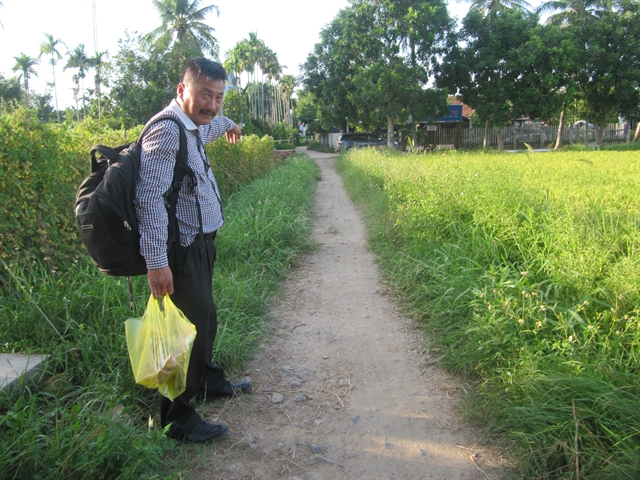
|
| PAINFUL MEMORIES: Mỹ Lai massacre survivor Trần Văn Đức returns to the place where more than 500 of his fellow villagers were killed by US soldiers of Charlie Charlie Company during the American War in 1968. VNS Photo Công Thành |
Hà and Mỹ stayed with their grandmother until they married. Hà lived with Mỹ’s family for a long time before building her own family.
Hà is now a retired primary school teacher, while Mỹ opened a shop in Tịnh Châu Commune – 4km from Mỹ Lai Village.
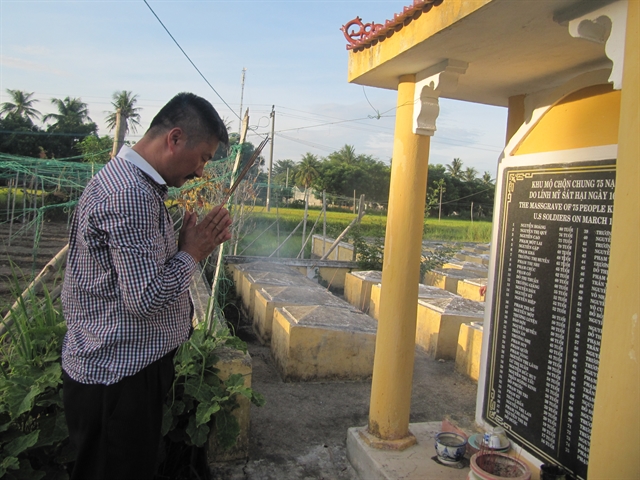
|
| PAYING RESPECT: Trần Văn Đức, a survivor of the Mỹ Lai massacre in Quảng Ngãi Province, comes to visit a 75-victim mass grave in the place where more than 500 unarmed civilians were killed on March 16, 1968. VNS Photo Công Thành |
Đức said his grandmother passed away in 2003 – four months after he paid a visit during her illness.
He married a woman, who was also from Sơn Tịnh District, in Germany in 1991 and had three sons.
Đức now lives in Remscheid, Germany and still works in a textiles factory.
He often comes home to visit his family's grave.
For him, each visit is filled with sorrowful memories of his bloody childhood. VNS

